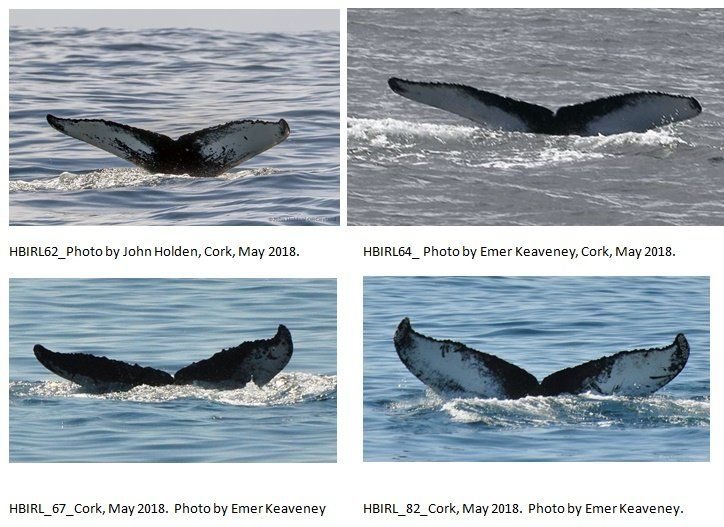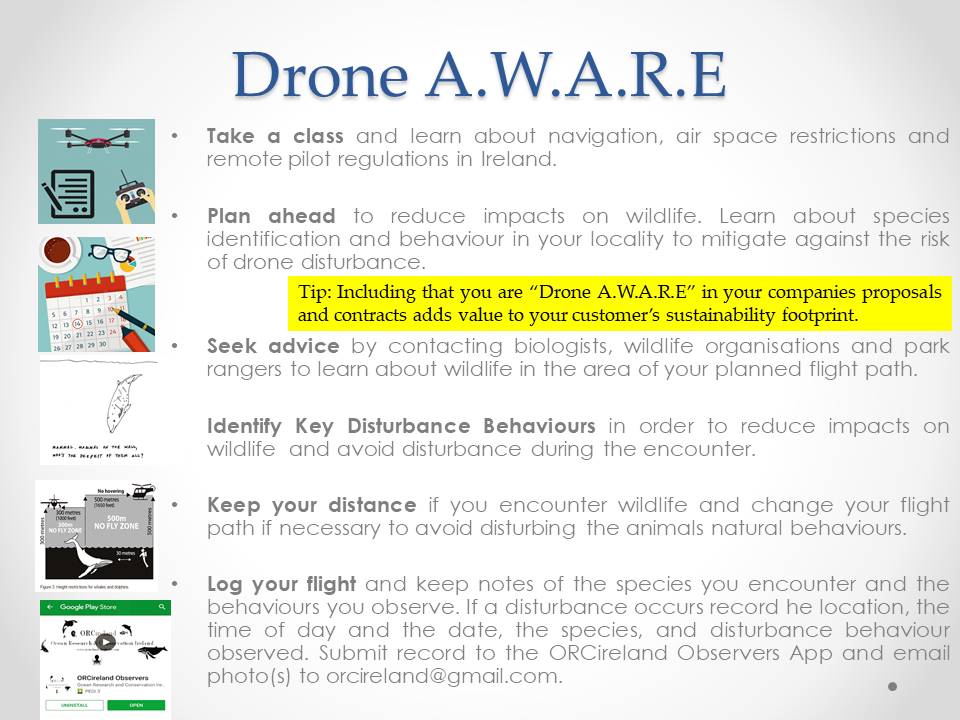Novel approach to studying whales in Irish waters with the use of unmanned aerial vehicles (UAV's).
Following a successful "test phase" during 2018, Ocean Research & Conservation Ireland (O.R.C.Ireland) are delighted to announce the continuation of valuable research on baleen whales along the south coast of Ireland during our third field season, using unmanned aerial vehicles (UAV's) or drones to help monitor whale's body condition and behaviour through-out the season.
On October 24th 2018, professional drone photographer, Greg Coleman, captured the first ever drone footage of a fin whale ( Balaenoptera physalus ) on-board eco-tour vessel "Holly Jo" of 'Cork Whale Watch', west Cork. Greg has always had a passion for photography and adventure and is one of many professionals that are more than happy to contribute to the conservation of cetaceans in Irish waters by working closely with O.R.C.Ireland scientists on the "FlukeFollow Project". The FlukeFollow Project aims to monitor whales and dolphins in Irish waters with minimal disturbance to the animals. That is where unmanned aerial vehicles or "drones" come in. Unmanned aerial vehicles (UAV's) have the potential to revolutionise cetacean research and despite the growing number of researchers using drones to study whale's around the world, this is a novel approach for Irish waters. Analysis of the drone footage of a foraging fin whale has revealed that the whale in question reached a whopping 19 meters in length and was travelling at a speed of 11.5 km/hr while on-side feeding (publication in review).
During our last field season we also obtained 10 humpback whale ( Megaptera novaengliae ) fluke I.D. images on-board eco-tour vessels in west Cork, and so are looking forward to this summer to extend our drone research to other species such as the humpback and minke whale ( Balaenoptera acutorostrata ).
With the use of UAVs quickly increasing and becoming more popular as a tool in wildlife research and monitoring (Jones et al
., 2006; Koh and Wish, 2012, Nowacek et al
., 2016), there is a growing concern about the impacts of disturbance to marine wildlife. UAV's or drone offer an excellent opportunity for researchers studying marine megafauna, attributed to the fact they offer a safe, inexpensive and user-friendly experience, so are an excellent alternative to traditional aerial survey methods i.e. using fixed wind aircrafts. Applications of drone in marine wildlife surveys include optical surveying and observation of animals, autonomous wildlife telemetry tracking and habitat mapping and monitoring (Anderson & Gatson, 2013; Chabot & Bird, 2015; Linchant et al
., 2015). Marine mammal research too has benefitted from the application of UAVs, providing tools to monitor the occurrence of animals (Jones et al
., 2006; Brooke et al
., 2015), abundance estimations (Sweeney et al.,
2016), Photo ID (Pomeroy et al
., 2015), photogrammetry (Durban et al.
, 2015; Goebel et al.
, 2015; Christiansen et al
., 2016). In addition drone have been used in the collection of biological samples, such as exhaled condensate (or whale "blow"), helping to monitor disease and hormone levels which otherwise would require invasive techniques like biopsy dart samples (Acevedo-Whitehouse et al.
, 2010).
Cetaceans are particularly vulnerable to disturbance from man-made noise in the marine environment, and can responses can include behavioural changes (e.g. avoidance behaviour), physiological effects (stress and hearing impairment), masking of communication and echo-location signals and changes in vocalisations (Tougard et al ., 2015). UAV's therefore, have the potential to cause disturbance to cetaceans, depending on the level of noise emitted from the drone and the altitude and direction it is flown at. Visual cues may also cause disturbance, highlighting the need for the use of drones around marine wildlife in Ireland to be well regulated (Smith et al ., 2016). Other marine mammals such as pinnipeds, have been shown to be disturbed by UAVs in haul-out areas, ranging from elevated alertness to animals fleeing into the safety of the water (Smith et al. , 2016).
A large part of O.R.C.Ireland's 'FlukeFollow Project' is raising awareness of the potential for eco-tourism and drone operators to cause disturbance to wildlife, such as marine mammals, particularly with how readily available UAVs have become and the increase in recreational users of drones in areas of important habitat for protected species, such as west Cork, where humpback whales gather to forage during the spring and summer months. This coupled with the reasoning that currently no regulations for drone use around vulnerable species to disturbance such as cetaceans exists in Ireland to date. Under the A.W.A.R.E ( A nimal W elfare A ware R esponsible E ncounters) Program we have outlined Codes of Conduct which will soon be available on our website, with "Best Practices" for whale and dolphin watching and drone filming. With the support of University College Cork and MaREI (Marine Renewable Energy Ireland)- ProtoAtlantic, we will provide training to commercial operators and professional photographers on how to observe marine mammals causing minimum disturbance.
© Ocean Research & Conservation Ireland (ORCireland) and www.orcireland.ie , est. 2017. Unauthorized use and/or duplication of this material without express and written permission from this site’s author and/or owner is strictly prohibited. Excerpts and links may be used, provided that full and clear credit is given to Ocean Research & Conservation Ireland and www.orcireland.ie with appropriate and specific direction to the original content.
References:
Acevedo-Whitehouse, K., Rocha-Gosselin, A., and Gendron, D. (2010). A novel non-invasive tool for disease surveillance of free-ranging whales and its relevance to conservation programs. Anim. Conserv.
13, 217–225. doi: 10.1111/j.1469-1795.2009.00326.x
Anderson, K., and Gaston, K. J. (2013). Lightweight unmanned aerial vehicles will revolutionize spatial ecology. Front. Ecol. Environ.
11, 138–146. doi: 10.1890/120150
Christiansen, F., Dujon, A. M., Sprogis, K. R., Arnould, J. P. Y., and Bejder, L. (2016). Noninvasive unmanned aerial vehicle provides estimates of the energetic cost of reproduction in humpback whales. Ecosphere
7:e01468. doi: 10.1002/ecs2.1468
Brooke, S., Graham, D., Jacobs, T., Littnan, C., Manuel, M., and O'Conner, R. (2015). Testing marine conservation applications of unmanned aerial systems (UAS) in remote marine protected area. J. Unmanned Veh. Syst.
3, 237–251. doi: 10.1139/juvs-2015-0011
Chabot, D., and Bird, D. M. (2015). Wildlife research and management methods in the 21st century: where do unmanned aircraft fit in? J. Unmanned Veh. Syst.
3, 137–155. doi: 10.1139/juvs-2015-0021.
Durban, J. W., Fearnbach, H., Barrett-Lennard, L. G., Perryman, W. L., and Leroi, D. J. (2015). Photogrammetry of killer whales using a small hexacopter launched at sea. J. Unmanned Veh. Syst. 3, 131–135. doi: 10.1139/juvs-2015-0020
Goebel, M. E., Perryman, W. L., Hinke, J. T., Krause, D. J., Hann, N. A., Gardner, S., et al. (2015). A small unmanned aerial system for estimating abundance and size of Antarctic predators. Polar Biol. 38, 619–630. doi: 10.1007/s00300-014-1625-4Jones, G. P., Pearlstine, L. G., and Percival, H. F. (2006). An assessment of small unmanned aerial vehicles for wildlife research. Wildl. Soc. Bull. 34, 750–758. doi: 10.2193/0091-7648(2006)34[750:AAOSUA
Koh, L. P., and Wich, S. A. (2012). Dawn of drone ecology: low-cost autonomous aerial vehicles for conservation. Trop. Conserv. Sci. 5, 121–132. doi: 10.1177/194008291200500202
Linchant, J., Lisein, J., Semeki, J., Lejeune, P., and Vermeulen, C. (2015). Are unmanned aircraft systems (UASs) the future of wildlife monitoring? A review of accomplishments and challenges. Mamm. Rev. 45, 239–252. doi: 10.1111/mam.12046
Nowacek, D. P., Thorne, L. H., Johnston, D. W., and Tyack, P. L. (2007). Responses of cetaceans to anthropogenic noise. Ma mm. Rev. 37, 81–115. doi: 10.1111/j.1365-2907.2007.00104.x
Pomeroy, P., Connor, L. O., and Davies, P. (2015). Assessing use of and reaction to unmanned aerial systems in gray and harbor seals during breeding and molt in the UK. J. Unmanned Veh. Syst. 3, 102–113. doi: 10.1139/juvs-2015-0013,
Smith, C. E., Sykora-Bodie, S. T., Bloodworth, B., Pack, S. M., Spradlin, T. R., and Leboeuf, N. R. (2016). Assessment of known impacts of unmanned aerial systems (UAS) on marine mammals: data gaps and recommendations for researchers in the United States. J. Unmanned Veh. Syst. 4, 1–14. doi: 10.1139/juvs-2015-0017
Sweeney, K. L., Helker, V. T., Perryman, W. L., LeRoi, D. J., Fritz, L. W., Gelatt, T. S., et al. (2016). Flying beneath the clouds at the edge of the world: using a hexacopter to supplement abundance surveys of Steller sea lions ( Eumetopias jubatus ) in Alaska. J. Unmanned Veh. Syst. 4, 1–12. doi: 10.1139/juvs-2015-0010
Tougaard, J., Wright, A. J., and Madsen, P. T. (2015). Cetacean noise criteria revisited in the light of proposed exposure limits for harbour porpoises. Mar. Pollut. Bull. 90, 196–208. doi: 10.1016/j.marpolbul.2014.10.051
SHARE THIS ARTICLE
















